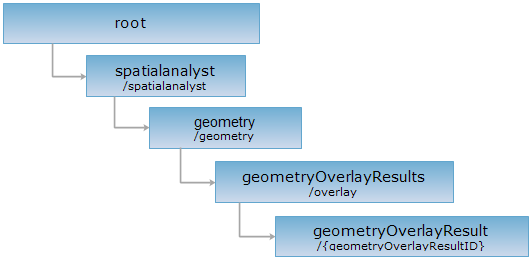
<geometryOverlayResults_uri>/{geometryOverlayResultID}[.<format>]
The geometryOverlayResult resource represents the result of a geometric object overlay analysis.
Supported methods:
Supported output formats: rjson, json, html, xml.

Implement the HTTP request on the following URI, with the output format being rjson, where supermapiserver is the server name.
http://supermapiserver:8090/iserver/services/spatialanalyst-sample/restjsr/spatialanalyst/geometry/overlay/1.rjson
Returns the overlay analysis result information.
After implementing the GET request, the response structure is as follows:
| Field | Type | Description |
| succeed | boolean | Whether overlay analysis is successful; returns true if successful, otherwise, returns false. |
| image | ImageResult |
Spatial analysis resulted image, expressing the SuperMap iServer spatial analysis result image and its related description. |
| message | String | The related information produced by overlay analysis process. |
| resultGeometry | Geometry | Spatial analysis resulted geometry. |
After implementing the GET request, the response in rjson format is as follows:
{
"image": null,
"message": null,
"resultGeometry": {
"id": 0,
"parts": [4],
"points": [
{
"x": 43,
"y": 22
},
{
"x": 23,
"y": 23
},
{
"x": 33,
"y": 35
},
{
"x": 43,
"y": 22
}
],
"style": null,
"type": "REGION"
},
"succeed": true
}
Asks for the response identical to the one that would correspond to a GET request, but without the response body. This is useful for retrieving meta-information written in response headers, without having to transport the entire content. The meta-information includes the media-type, content-encoding, transfer-encoding, content-length, etc.
The HEAD request helps check the existence of the geometryOverlayResult resource and whether it can be accessed by the client. By implementing the HEAD request on the URI, with .<format> appended to the end, we can quickly get to know whether the geometryOverlayResult resource supports the representation in <format> or not.